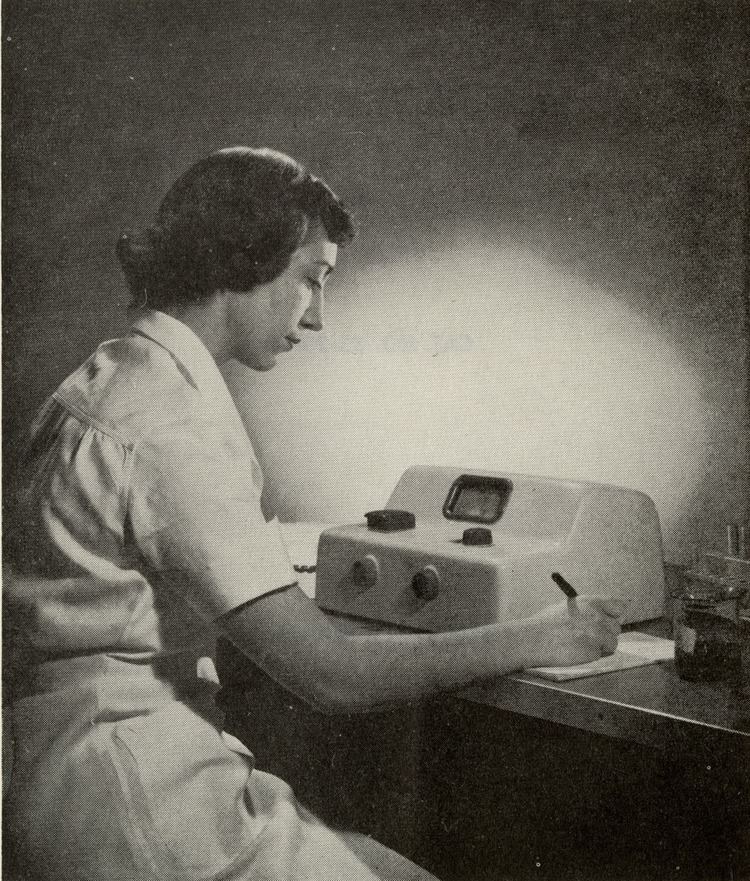 | ||
The Spectronic 20 is a single-beam spectrophotometer, designed to operate in the visible spectrum across a wavelength range of 340 nm to 950 nm, with a spectral bandwidth of 20 nm. Because it measures the transmittance or absorption of visible light through a solution, it is sometimes referred to as a colorimeter.
Contents
Developed by Bausch & Lomb and launched in 1953, the Spectronic 20 was the first low-cost UV-Vis spectrophotometer. It rapidly became an industry standard due to its low cost, durability and ease of use, and has been referred to as an "iconic lab spectrophotometer". Approximately 600,000 units were sold over its nearly 60 year production run. It has been the most widely used spectrophotometer worldwide. Production was discontinued in 2011 when it was replaced by the Spectronic 200, but over 300,000 instruments are believed to remain in use in chemistry laboratories in both commercial and educational settings around the world.
Design
The Bausch & Lomb Spectronic 20 colorimeter contained a diffraction grating monochromator combined with a system for the detection, amplification, and measurement of light wavelengths in the 340 nm to 950 nm range.
As shown in the schematic optical diagram (see left), polychromatic light from a source in the system passed through lenses and was reflected and dispersed by the diffraction grating to restrict the range of light wavelengths. This restricted range of wavelengths was then passed through the sample to be measured. The remaining frequencies of light were registered on a phototube to determine what had been absorbed. Proper calibration and movement of the diffraction grating using the wavelength control enabled the user to scan for various wavelengths.
Use
Measuring all the wavelengths that a substance absorbs enables a researcher to determine the absorption spectrum of the substance. Through comparison to other known spectra it becomes possible to identify the substance based on its composition, or to classify it as belonging to a particular class of compounds. The absorption maximum, or wavelength at which peak absorption occurs, is very useful when trying to identify an unknown. It is the most sensitive operating wavelength to choose when testing a substance.
Before testing a sample, the Spectronic 20 had to be calibrated using a blank solution, such as a test tube of distilled water. After this was done, the user placed a 1/2 inch test tube or cuvette, containing the sample solution to be measured, into the sample compartment. The blank was used to adjust the spectrophotometer each time the wavelength was changed. It or a standard reference sample was used to periodically check for drift when working with a single wavelength. To measure wavelengths above 350 nm, the bottom of the instrument had to be opened, and a red filter and a red-sensitive photocell had to be installed.
The original design of the Spectronic 20 utilized an analog dial for readout of transmission from 100%T to 1%T (top scale), 0A - 2A (lower scale). Using the original instrument requires manual setting of the wavelength and making readings from a moving-needle analog display.
Transmittance and absorbance of light are related and can be converted according to Beer's law. Either type of curve can therefore be plotted using measurements from the Spectronic 20. Plotting a curve using percent transmittance of light will yield an exponential curve (see example, right).
Because plotting a calibration curve using absorbance of light will result in a linear relationship, using absorbance is often preferred for plotting a calibration curve. This type of calibration curve (or standard curve) relates the concentration of the solution (on the x-axis) to measures of its absorbance (y-axis). To obtain such a curve, a series of dilutions (of known concentration) of a solution were prepared and readings obtained for each of the dilutions. By creating and measuring a series of standards, it is possible to quantify the amount or concentration of a substance within a sample.
The Spectronic 20D (launched in 1985) and then 20D+ replaced the analog dial with a red LED readout, offering greater precision in the readout, if not greater accuracy in the actual reading. A side-by-side comparison of the features of the 20+ and 20D+ is available in the 2001 operating manual.
Replacement
The Spectronic 20 was replaced by the Spectronic 200 in the Thermo Scientific spectrophotometer product line in 2011. The Spectronic 200 utilizes an array detector and digital control of the measured wavelength, while retaining the characteristic λ knob of the SPEC 20 for setting the wavelength. In addition to replicating the user modes of the Spec 20D+ (which it can emulate on a color LCD screen) the Spec 200 accommodates both test-tubes and square cuvettes without needing to install an adapter. Software modes described in the Spectronic 200's specifications include scanning, four wavelength simultaneous measurement and quantitative analysis with up to four standards, in contrast to the SPEC 20D+ which offered only single point calibration.
Product line history
Originally introduced by Bausch & Lomb in 1953, the product line was sold to Milton Roy in 1985. Milton Roy sold its instrument group to Life Sciences International, renamed Spectronic instruments, Inc. in 1995. Spectronics Instruments was purchased by Thermo Optek in 1997, renamed Spectronic-Unicam in 2001 and Thermo-Spectronic in 2002. In 2003 the product line was moved to Madison, WI and the brand renamed to Thermo Electron.
With the merger of Thermo Electron and Fisher Scientific in 2006 the brand changed to Thermo Scientific, and remained such until the end of the production run. Spectronic 20 instruments found in labs today may bear any of the Bausch and Lomb, Milton Roy, Spectronic, Thermo Electron or Thermo Scientific brands.
Popular culture
The Spectronic 20 is apparently one of the few lab instruments to remain intact after the destruction of the laboratory in the movie Back to the Future.
